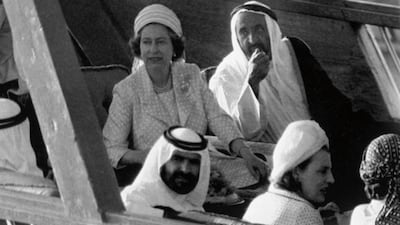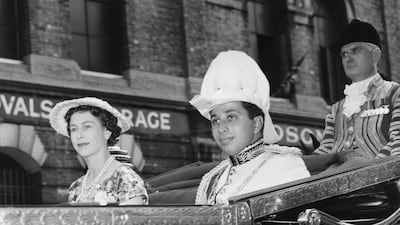Queen Elizabeth II dies - follow the latest news as the world mourns
It was the workers on Das Island who saw her first, emerging out of the sea mist in stately procession towards Abu Dhabi.
All eyes were on the royal yacht Britannia, which was carrying Queen Elizabeth of Great Britain on her first state visit to the UAE.
The date was February 24, 1979, and waiting on the quayside at Mina Zayed was Sheikh Zayed, founding President of a country that was then only eight years old.
As well as dignitaries, who included Sheikh Rashid bin Saeed, then Ruler of Dubai, and the other five Rulers of the UAE Supreme Council, a large crowd had gathered, anxious to witness this historic event.
"Disembarking from the Britannia, the Queen was presented with flowers by two small girls," the New York Times wrote in its edition of 40 years ago, noting the "warm welcome from Government officials and thousands of cheering citizens".
The fact that the Times was covering the visit is an indication of its global importance. The region was in turmoil, with the Arabian Gulf kingdoms an oasis of stability.
Even as Britannia passed down the Arabian Gulf it took her perilously close to the waters of Iran, where a violent revolution had seen the Shah overthrown, and the creation of an Islamic republic under Ayatollah Khomeini less than two weeks before.
International public interest in the visit was high.
"There was intense interest to see really how the rulers in the Gulf would welcome a woman monarch and to see how the public would react as well," Keith Graves, the former BBC Middle East correspondent, told The National in an interview in 2010.
"You had a queen, a woman, visiting a part of the world where women were not high profile.”
For the British government, the royal visit was also of great importance, taking the Queen to a region whose long ties with Britain had been both transformed and loosened by the formation of the UAE in 1971.
London also eyed the possibility of lucrative trade deals with the oil rich Gulf states. For the first time it chartered an aircraft to bring along 60 members of the press.
Her Majesty, meanwhile, departed from Heathrow on Concorde, the shiny new supersonic passenger aircraft serving as a sale pitch for British technology. But after landing in Kuwait, it was the then 25-year-old Britannia that would continue the tour.
The visit would last three days, beginning with a tour of the new city, including the Corniche Hospital and a stop at the British School Al Khubairat where the Queen, in a mint green outfit with matching hat, was presented with a bouquet by four-year-old Victoria Evans, the youngest girl pupil.
There was a holiday atmosphere, as crowds lined the street to watch the Queen and Sheikh Zayed pass in a Mercedes limousine flying the Royal Standard and the flag of the UAE. On the beach, a British Airways hot air balloon was launched.
Away from the media, the Queen enjoyed a private meeting at Mushrif Palace with Sheikha Fatima, the wife of Sheikh Zayed.
The day ended with a State Banquet at 10pm on board the Royal Yacht in honour of Sheikh Zayed, to thank the President and the other Rulers for their hospitality.
The following day saw a visit to Al Ain University, with a spot of camel racing in the Garden City, of which Mr Graves said ”she clearly thought this was absolutely wonderful and quite spectacular”.
Members of the media found the hospitality also extended to them. All 60 were allocated an individual car and driver.
For the BBC’s man it was a Rolls Royce all to himself. Lunch was a desert barbecue, with roast lamb, tents and traditional music and dancing.
The next day was Sunday, with the Queen flying from Al Ain to Dubai. Met at the airport by Sheikh Rashid, the royal party unveiled a plaque at the new Municipality building, with the Queen and her husband, Prince Philip, the Duke of Edinburgh, attending a service at Holy Trinity Church in Bur Dubai.
Overnight, the Royal Yacht sailed from Abu Dhabi to the new port at Jebel Ali which was formally opened by the Queen on the Monday, along with a desalination plant.
"It is one of man's ancient dreams to turn the desert green and seawater fit for drinking," she was quoted as saying by the newspaper Al Ittihad. "Here in Dubai, this dream will become reality."
Next the Queen was taken to the top of the Trade Centre - to inaugurate what was then the tallest building in the Middle East - and for dhow trip along the Creek.
There was a visit to the British Embassy in Dubai on the waterside, and finally an evening reception, again on Britannia, before the Royal party finally departed the UAE for Oman and the final leg of their Arabian tour.
The Queen returned to the UAE in 2010. Sheikh Zayed paid a state visit to Britain in 1989, with the late President, Sheikh Khalifa afforded the same honour in 2013. Less formally, Sheikh Mohammed bin Rashid, the Vice President and Ruler of Dubai was frequently seen with the Queen at the horse racing meetings they both love.
As the world mourns Queen Elizabeth, those special memories of her time in the UAE are all the more precious.
How to apply for a drone permit
- Individuals must register on UAE Drone app or website using their UAE Pass
- Add all their personal details, including name, nationality, passport number, Emiratis ID, email and phone number
- Upload the training certificate from a centre accredited by the GCAA
- Submit their request
What are the regulations?
- Fly it within visual line of sight
- Never over populated areas
- Ensure maximum flying height of 400 feet (122 metres) above ground level is not crossed
- Users must avoid flying over restricted areas listed on the UAE Drone app
- Only fly the drone during the day, and never at night
- Should have a live feed of the drone flight
- Drones must weigh 5 kg or less
The Bio
Name: Lynn Davison
Profession: History teacher at Al Yasmina Academy, Abu Dhabi
Children: She has one son, Casey, 28
Hometown: Pontefract, West Yorkshire in the UK
Favourite book: The Alchemist by Paulo Coelho
Favourite Author: CJ Sansom
Favourite holiday destination: Bali
Favourite food: A Sunday roast
UAE squad
Humaira Tasneem (c), Chamani Senevirathne (vc), Subha Srinivasan, NIsha Ali, Udeni Kuruppuarachchi, Chaya Mughal, Roopa Nagraj, Esha Oza, Ishani Senevirathne, Heena Hotchandani, Keveesha Kumari, Judith Cleetus, Chavi Bhatt, Namita D’Souza.
The specs
Engine: 5.2-litre V10
Power: 640hp at 8,000rpm
Torque: 565Nm at 6,500rpm
Transmission: 7-speed dual-clutch auto
Price: From Dh1 million
On sale: Q3 or Q4 2022
All%20The%20Light%20We%20Cannot%20See%20
%3Cp%3E%3Cstrong%3ECreator%3A%20%3C%2Fstrong%3ESteven%20Knight%3C%2Fp%3E%0A%3Cp%3E%3Cstrong%3EStars%3A%C2%A0%3C%2Fstrong%3EMark%20Ruffalo%2C%20Hugh%20Laurie%2C%20Aria%20Mia%20Loberti%3C%2Fp%3E%0A%3Cp%3E%3Cstrong%3ERating%3A%20%3C%2Fstrong%3E1%2F5%C2%A0%3C%2Fp%3E%0A
Tips to stay safe during hot weather
- Stay hydrated: Drink plenty of fluids, especially water. Avoid alcohol and caffeine, which can increase dehydration.
- Seek cool environments: Use air conditioning, fans, or visit community spaces with climate control.
- Limit outdoor activities: Avoid strenuous activity during peak heat. If outside, seek shade and wear a wide-brimmed hat.
- Dress appropriately: Wear lightweight, loose and light-coloured clothing to facilitate heat loss.
- Check on vulnerable people: Regularly check in on elderly neighbours, young children and those with health conditions.
- Home adaptations: Use blinds or curtains to block sunlight, avoid using ovens or stoves, and ventilate living spaces during cooler hours.
- Recognise heat illness: Learn the signs of heat exhaustion and heat stroke (dizziness, confusion, rapid pulse, nausea), and seek medical attention if symptoms occur.
21 Lessons for the 21st Century
Yuval Noah Harari, Jonathan Cape
High profile Al Shabab attacks
- 2010: A restaurant attack in Kampala Uganda kills 74 people watching a Fifa World Cup final football match.
- 2013: The Westgate shopping mall attack, 62 civilians, five Kenyan soldiers and four gunmen are killed.
- 2014: A series of bombings and shootings across Kenya sees scores of civilians killed.
- 2015: Four gunmen attack Garissa University College in northeastern Kenya and take over 700 students hostage, killing those who identified as Christian; 148 die and 79 more are injured.
- 2016: An attack on a Kenyan military base in El Adde Somalia kills 180 soldiers.
- 2017: A suicide truck bombing outside the Safari Hotel in Mogadishu kills 587 people and destroys several city blocks, making it the deadliest attack by the group and the worst in Somalia’s history.
How to help
Send “thenational” to the following numbers or call the hotline on: 0502955999
2289 – Dh10
2252 – Dh 50
6025 – Dh20
6027 – Dh 100
6026 – Dh 200
The Uefa Awards winners
Uefa Men's Player of the Year: Virgil van Dijk (Liverpool)
Uefa Women's Player of the Year: Lucy Bronze (Lyon)
Best players of the 2018/19 Uefa Champions League
Goalkeeper: Alisson (Liverpool)
Defender: Virgil van Dijk (Liverpool)
Midfielder: Frenkie de Jong (Ajax)
Forward: Lionel Messi (Barcelona)
Uefa President's Award: Eric Cantona
Conflict, drought, famine
Estimates of the number of deaths caused by the famine range from 400,000 to 1 million, according to a document prepared for the UK House of Lords in 2024.
It has been claimed that the policies of the Ethiopian government, which took control after deposing Emperor Haile Selassie in a military-led revolution in 1974, contributed to the scale of the famine.
Dr Miriam Bradley, senior lecturer in humanitarian studies at the University of Manchester, has argued that, by the early 1980s, “several government policies combined to cause, rather than prevent, a famine which lasted from 1983 to 1985. Mengistu’s government imposed Stalinist-model agricultural policies involving forced collectivisation and villagisation [relocation of communities into planned villages].
The West became aware of the catastrophe through a series of BBC News reports by journalist Michael Buerk in October 1984 describing a “biblical famine” and containing graphic images of thousands of people, including children, facing starvation.
Band Aid
Bob Geldof, singer with the Irish rock group The Boomtown Rats, formed Band Aid in response to the horrific images shown in the news broadcasts.
With Midge Ure of the band Ultravox, he wrote the hit charity single Do They Know it’s Christmas in December 1984, featuring a string of high-profile musicians.
Following the single’s success, the idea to stage a rock concert evolved.
Live Aid was a series of simultaneous concerts that took place at Wembley Stadium in London, John F Kennedy Stadium in Philadelphia, the US, and at various other venues across the world.
The combined event was broadcast to an estimated worldwide audience of 1.5 billion.
The specs
Engine: 3.0-litre six-cylinder turbo
Power: 398hp from 5,250rpm
Torque: 580Nm at 1,900-4,800rpm
Transmission: Eight-speed auto
Fuel economy, combined: 6.5L/100km
On sale: December
Price: From Dh330,000 (estimate)
The specs
Engine: 2-litre 4-cylinder and 3.6-litre 6-cylinder
Power: 220 and 280 horsepower
Torque: 350 and 360Nm
Transmission: eight-speed automatic
Price: from Dh136,521 VAT and Dh166,464 VAT
On sale: now
























